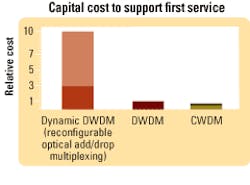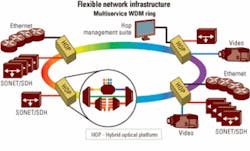ROADMs are not for everyone
By Per Hansen
Enterprises increasingly rely on networked applications to improve productivity. Enterprise IT staffs have scaled internal LANs to accommodate the rise of high-bandwidth applications, including Internet access and business continuity.
Upgrading the MANs-conceived and optimized strictly for traditional voice services-that connect the LANs is a more daunting proposition, potentially complex and expensive. Although market enthusiasm is mounting for managed Ethernet and storage services, service providers face risks such as limited visibility into future demands in the context of which they must make their network investments.
Given that they must also facilitate new high-bandwidth services such as broadcast and on-demand video and audio content, service providers seek to affordably transform their metro access, metro core, and regional networks into demand-responsive infrastructures. To this end, the industry is moving toward a dynamic optical provisioning model.
But the competitiveness of a service provider’s offerings will depend on careful selection of network platforms that can be tailored to widely varying network characteristics and traffic demands. While reconfigurable optical add/drop multiplexers (ROADMs) are appearing in highest-capacity areas, their cost premium has deterred wide-scale deployment. Service providers are proving to be wisely choosy in their network investments. Full reconfigurability does not prove necessary, for example, where traffic patterns are reasonably predictable and static.
How can service providers most cost-effectively accommodate today’s range of needs, while readying themselves for tomorrow’s challenges and opportunities? It takes, first and foremost, a comprehensive assessment of traffic patterns-strong indicators of the timing and direction of necessary network architecture evolution.
Leading edge Ethernet and storage applications promise companies unprecedented benefits, including boosted productivity, enhanced business processes, and reduced costs of doing business. Enterprise IT staffs, however, have been reduced to the point that they’re already overburdened-without the additional workload entailed with the implementation of new services. Meanwhile, uptake for high-speed Internet access for home users continues to escalate. Service providers are expanding their consumer offerings to include higher-speed Internet connectivity and triple play services. The trends are creating significant revenue opportunities for service providers, but they’re also exposing the rigidity and other weaknesses of their MAN and regional networks.WDM delivers critical flexibility, scalability, protocol transparency, and cost-efficiencies. Applications of any recognized protocol are multiplexed over the same optical fiber. Protocol conversion is unnecessary, and applications perform at native speed. Plus, service provisioning is dynamic in WDM. Cards can be provisioned remotely, and upgrades can be initiated only on the links where additional capacity or application support is required.
The next big step will be full remote reconfigurability of the optical transport layer, expanding dynamic provision into the spectral domain. With ROADMs maturing, service providers are considering whether this technology’s time has at last arrived.
“ROADM” has been a buzzword in the telecom industry for some time. Deployed in network nodes, ROADMs enable the network management system to control whether wavelengths are routed through the node or to a local port on the node, where they may be terminated on a transponder. ROADMs can switch individual wavelengths between at least two ports. Through-ports support WDM signals, whereas the local ports may be wavelength-agnostic or -specific. More advanced ROADMs support additional features, including continuous control of each wavelength’s power.
ROADMs promise a range of important benefits to service providers: rapid service provisioning and greater process automation, simplified network planning and engineering, and enhanced monitoring, control, and scalability. But while they have long been predicted to become integral elements of telecommunications networks of almost every type, ROADMs have remained largely on the sideline.
Price is the thing-ROADMs have thus far failed to make economic sense for many areas of the network and types of traffic patterns. Consequently, service providers have resisted the investment.
Service providers ultimately will need ROADM technologies to support application- and network-requested bandwidth provisioning. That is not the case today. The commercial appearance of such a model will wait at least until universal interoperability of equipment is demonstrated.The truth is that much of the traffic in a service provider’s network today is predictable. First and foremost, the initial demands that trigger network deployment in a success-based business model are inherently known. Through-traffic on networks that are part of the Internet backbone, backbone connectivity for data-centric business concentrations, customer areas where competition is sparse, even hubbed traffic to the backbone gateway…in each of these cases, service providers have a strong sense of how much bandwidth will be originated in individual nodes in their networks. And the vast majority of this traffic is not temporary in nature. In these cases, “nailed-up” bandwidth accommodates the demands more cost-effectively than can ROADMs.
Dynamic reconfigurability does, however, prove valuable as random, unpredictable bandwidth needs in MANs continue to grow. Certain services and their bandwidth requirements are inherently difficult-and, in some cases, impossible-to predict. Areas of the access network where the service provider faces considerable competition (where customer churn might be high) can see significant surges and ebbs in bandwidth demand. Connectivity links to small- and medium-sized businesses (SMBs) running sophisticated data applications can prove unpredictable since they’re dependent on the expansion, shrinkage, or relocation of a given SMB. Areas where a provider predominantly serves consumer demands can also prove unpredictable as factors such as variation in adoption of high-speed Internet and entertainment services across neighborhoods come into play. For these types of services and areas of unpredictable bandwidth demands, ROADMs prove to be an unusually valuable tool in preventing truck rolls from savaging a service provider’s profitability.
ROADMs at the same time render a network more self-controlling and enable remote provisioning. That’s valuable functionality-and it comes at a price (see Figure 1). The concept of any-to-any-node connectivity inherently carries additional costs in amplification and dispersion compensation as well. These costs are a deterrent to wide-scale ROADM adoption. The good news is that the price is coming down, and different service providers will be adopting ROADMs at different points in the price decline.
Carriers with the largest headcounts and reliance on manual processes, such as the RBOCs, stand to be the first large-scale adopters of ROADM technology since they would see the greatest decreases in operational expenditures. Smaller fast-growing service providers might also prove to be early adopters, though the factors in their strategic decision would be different. Deployment of ROADM functionality would enable CLECs, for example, to avoid increasing headcount to accommodate increased demand for services and improve their competitiveness in terms of service turn-up time.
Also, there are equipment manufacturers pursuing alternative methods for bringing down the hurdles to deployment. A true hybrid architecture for optical platforms looms as an important feature (see Figure 2). That would give service providers the ability to simultaneously deploy CWDM and DWDM as well as static and dynamic routing features in the same optical platform along the same fiber pair. Such an architecture delivers a magnitude of flexibility greater than what is currently offered from standalone DWDM or CWDM systems. Today’s merely modular optical platforms impose high up-front cost to support dynamic provisioning that may not be required until years later.
A competitive network infrastructure remains any service provider’s most important asset. Flexibility and scalability are keys to ongoing business success, and ROADMs offer service providers unprecedented benefits in these areas.
In most instances, however, the business case isn’t yet strong enough to merit wide-scale ROADM deployment. While the industry is moving toward a dynamic optical provisioning model, service providers are wisely taking a pragmatic, measured approach to enhancing their MANs and regional networks to answer heightened demand for high-bandwidth Ethernet and storage services.
With full reconfigurability necessary only for temporary demands and traffic with truly unpredictable path and bandwidth requests, many service providers find value in a hybrid optical architecture-enabling them to deploy ROADM functionality as well as lowest-cost CWDM and static routing along the same fiber pair.Per Hansen is director of business development for ADVA Optical Networking (Mahwah, NJ, www.advaoptical.com).


